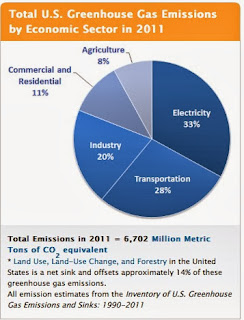New Years Resolution (sort of) - Cut 1 million tons of CO2 in 22 months
After a really wonderful meeting today with Mary Hendriks with the Australian Solar Council, I finally committed to a goal that had been rolling around in my head for a while now. It's not really a new years resolution, since it spans more than a year and really has nothing to do with new years.
My goal is to prevent or reduce 1 million metric tons of C02 emissions before I turn 25. That gives me about 22 months. I know it is a bit crazy, but that's kind of the point. Now, I bet you are wondering (much like I was a few hours ago) what is 1 million tons of CO2? I probably should have answered that question before I set the goal, but then the more sane (and less optimistic) part of my brain would have had its say. I have learned that you shouldn't think about the viability of goals when you make them. You sell yourself short.
So to figure out what 1 million tons (or megaton - Mt) really means I did a bit of research. The picture below is from the EPA website and describes the US GHG emissions for 2011.
My goal is to prevent or reduce 1 million metric tons of C02 emissions before I turn 25. That gives me about 22 months. I know it is a bit crazy, but that's kind of the point. Now, I bet you are wondering (much like I was a few hours ago) what is 1 million tons of CO2? I probably should have answered that question before I set the goal, but then the more sane (and less optimistic) part of my brain would have had its say. I have learned that you shouldn't think about the viability of goals when you make them. You sell yourself short.
So to figure out what 1 million tons (or megaton - Mt) really means I did a bit of research. The picture below is from the EPA website and describes the US GHG emissions for 2011.
As you can see, the US produced 6.7 gigatons of C02 equivalent in 2011, which means that in 22 months I want to reduce US emissions by 0.015%. Now it really sounds crazy, but I was considering trying to shoot for 1 Gt, which would have been 15% of US emissions - which really is crazy. I was relieved that I arbitrarily picked 1 Mt instead of 1 Gt.
All this talk of crazy goals aside, I think it is feasible. I believe that in the infinite possibility for the future, there exists at least one set of occurrences that results in me reducing emissions by 1 Mt in 22 months (which does not involve starting a nuclear war). All I need to do is find the path that leads to that outcome.
One idea that came up with my conversation with Mary had to do with the State Water Project (SWP) in California. Transporting water from the San Joaquin delta in northern California to southern California consumes about 2-3% of California's total energy, or 1/3 of the electricity use of homes in southern California. We talked about how solar panels have been used to cover aqueducts in other countries like India and the possibility of doing that in CA.
I just did a few ballpark calculations to see how much CO2 would be reduced if the SWP ran all on solar power. From a 2004 study, the STP consumes an average of 5 TWh/yr (5 Billion kWh/yr). I then looked up various conversion from kWh to C02, which of course depends upon the electricity generation. A 2001 paper by the famed CA energy commission Art Rosenfeld, says that 5 TWh from a power plant produces 3 Mt of C02 (1.3 lbs C02 per kWh). I checked this conversation with other sources. A particularly good one was the EIA website which gave a range of C02 emission for coal and natural gas generation. The conversion for natural gas was 1.22 lbs C02 per kWh. Natural gas is the largest electricity producer in CA at 40% of all generation, so I think 1.2 lbs C02 per kWh is a reasonable conversion factor.
This little back of the envelope calculation shows that providing 1/3 of the SWP's energy with solar power would achieve my goal! It also gives a scope of its magnitude. While this may be encouraging, from my experience with water recycling in Claremont, getting anything done that involves public entities tends to take a long time, so I need to balance this fact against my rather narrow 22 month time frame.
Definitely a lot to think about, but this was a good start. Converting my goal into SWP units, I aspire to cut the largest energy consumer in CA by 33% in 22 months. As Ray Dalio puts it, "The more creative I am, the less hard I have to work." Let's see how creative I can be.


